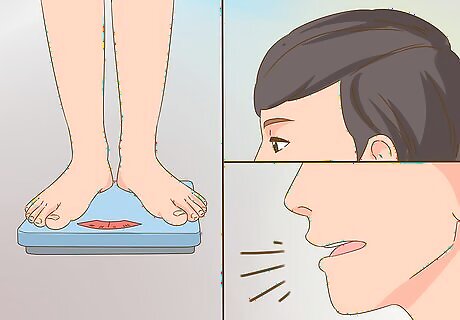
views
Coming Out to Others as Transgender

Think through who you will tell and what you will say. If you haven’t already, make a plan to come out as transgender. Start by telling people who you trust. They can help serve as a support system. Choose a good time and place where you will be able to have a private, uninterrupted talk. You might tell your sister, “I have something important I’d like to talk to you about. Can you come over Friday evening?” Then you can say whatever makes you comfortable. “I’m transgender and I identify as a male,” might be a good place to start.

Talk to people who are supportive. You don't have to tell anyone that you don't want to. If you only want to tell 1 friend or family member, that's fine. This is your news to share. If you have someone who is supportive of you, consider asking them to be with you while you come out to others. They can be a great source of moral support! Before you come out, make sure that doing so won’t endanger your health, safety, or living situation. If you think there might be a problem, have a safety plan in place. That means having a bag with some essentials packed and ready to go. Plan ahead to stay at a friend or family member's house, if necessary. Make sure that you are completely comfortable with your own identity before discussing it with others.

Research being trans so that you are prepared to answer questions. Unfortunately, many people don’t understand what it means to be trans. It’s likely that they will have plenty of questions for you. Take some time to gather lots of facts about being trans and transitioning. You can share this information with those who have questions. You can search online for helpful information. You could also reach out to a local LGBT center and ask them for good resources.

Give people time to process your news. Hopefully, you are met with immediate support and love. But some people might need time to adjust to knowing that you are trans. That’s okay; it probably took you a little while to come to terms, too. You can say something like, “Thanks for listening. I know this is a lot to process. Maybe we can get together in a couple of days after you’ve had time to think?”

Look into laws in your area before coming out at work. There is no federal law that protects people from being fired because of their gender identity or expression. Many states and cities, however, do have protections in place. If you think your gender identity might cause problems for you at work, check the laws where you live. If there are not explicit protections in place, you might want to contact a lawyer for some advice. If you are still in school, you might want to talk to an adult before you decide to come out. A favorite teacher or the school counselor can help you decide how open you want to be at school. Hopefully, everyone will be supportive. But if you are bullied, these people will be ready to support you.

Find a support system to help you deal with your emotions. Even when it goes smoothly, deciding to transition can be a really emotional experience. In addition to trusted family and friends, reach out to others for support. It can be especially helpful to talk to others who have transitioned to get some advice. Look for LGBT support groups in your community. You can also find support from national organizations like The Trevor Project and PFLAG.
Making the Transition Socially

Ask people to use your preferred pronouns. One of the first steps of your transition can be letting people know the gender you identify with. Pronouns are important because they let people know how you like to be referred to. When you meet a new person, you can say, “Hi! I'm Taylor, and I'd love it if you could use he/him when you're referring to me.” You can gently correct people who use incorrect pronouns when referring to you. Try saying, “Can you please either use he/him pronouns or just use my name? Thanks so much.”

Change your name if you want to. Everyone chooses to transition differently. Remember that you can make whatever choices you want. If you want to change your name, you can do so legally or just socially. You can start slowly by just asking friends and family to call you by your new name. You can say, “I know you know me as Sara, but I’m going by Sam now.”

Alter your grooming and clothing to be more masculine if you want to. You can also further your transition by changing your appearance. You might want to try a short haircut, for instance. You can also start shopping in the men’s section for your clothing and shoes. You could try wearing something like jeans and a blazer when you go out for the evening. Remember, what's most important is that you feel comfortable. EXPERT TIP Eric A. Samuels, PsyD Eric A. Samuels, PsyD Clinical Psychologist Eric A. Samuels, Psy.D. is a Licensed Clinical Psychologist in private practice in San Francisco and Oakland, California. He received a Psy.D. in Clinical Psychology from The Wright Institute in 2016 and is a member of the American Psychological Association and Gaylesta, the Psychotherapist Association for Gender and Sexual Diversity. Eric specializes in working with men, young adults, and people with diverse sexual orientations and gender identities. Eric A. Samuels, PsyD Eric A. Samuels, PsyD Clinical Psychologist Consider binding if you're self-conscious about your breasts. Many of my clients who are transitioning to male choose to bind their chest, and they may wear clothing that's more typically associated with men. You can also have top surgery to alter your appearance permanently, but research shows that the vast majority of people who identify as gender expansive, or transgender, don't actually engage in a surgical procedure.
Using Hormone Therapy to Transition

Find out what your insurance will cover. Transitioning medically is unfortunately often expensive. Actual costs will vary depending on where you live and who your doctor is, but it will likely cost several thousand dollars. However, there is some good news! More and more insurance plans are covering all or parts of the cost of transitioning. First, talk to your doctor and get an explanation of expected treatments and costs. Next, examine your insurance plan. If you can't tell from reading your policy what is covered, call and speak to a representative. Both employer-based plans and Medicare and state marketplace plans are starting to cover more of the costs of transitioning.

Make an appointment with an experienced doctor. If your doctor doesn’t have experience helping people transition, seek out a doctor with expertise. They’ll be better able to guide you through the process and answer your questions. Schedule an appointment and talk to your doctor about what steps you want to take to transition medically. Hormone therapy will likely be the first step. Talk to your doctor about risks associated with hormone therapy. As a result of hormone therapy, your overall health profile will be that of a male. That may mean you are at greater risk for conditions like heart disease and high blood pressure.

Choose the right dosage and method for you. Testosterone can be taken in 3 ways: orally (pill), through a skin patch or gel, or with an injection. The right method for you will depend on your individual health needs. Talk through each of these options with your doctor. Don't be afraid to ask lots of questions. They're there to help you! Oral testosterone is the least effective, so it's not as commonly used. If you use transdermal therapy, you will be using a skin patch or gel each day. If your doctor recommends injections, you'll typically get a shot either once a week or every 2 weeks. Doses vary greatly. It might take some time for you and your doctor to figure out what's right for you.

Expect changes to your skin to come first. Shortly after you begin taking testosterone, your skin will start to look and feel different. Your pores will be larger and you might notice that your skin is thicker and more oily. It’s not uncommon to experience some acne flare-ups. Your sense of touch might also change, and things might “feel” different when you touch them.

Look for weight, hair, and voice changes to follow. You might notice that you begin to carry weight differently. For example, you might see less weight in your hips and thighs, and more in your abdomen. Overall, your muscle mass will probably increase. Listen for changes in your voice after a few weeks. The testosterone will cause your vocal cords to thicken, which will result in a more traditionally male-sounding voice. Expect your hair to change slowly over time, and get thicker and darker. The hair on your body will start to become darker and thicker. It will also grow at a faster rate.

Ask your doctor about changes to your reproductive system. You may notice that your periods become lighter, less frequent, or stop altogether. However, you might also experience longer, heavier periods for a while. Each person reacts differently to testosterone therapy. If you have any concerns, talk to your doctor. They can help you figure out what’s normal for you.

Go to therapy if you find your emotional changes challenging. Make an appointment with a therapist if you are having trouble dealing with emotions. Hormone therapy is a lot like going through puberty again. That means that not only will you experience physical changes, but you might also find yourself on an emotional roller coaster. Transitioning is an emotional process, even without hormones surging through your body! In therapy, you can learn various coping mechanisms that may be useful.
Undergoing Surgical Procedures

See a therapist to get a diagnosis, if necessary. Gender dysphoria is a recognized health condition where a person’s gender identity does not match the sex they were born with. It is not a mental illness, so no need to have concerns that doctors look at it that way. Some doctors might require this diagnosis before they will perform surgery. Therapy is not only important to get a diagnosis, but it’s a good way to find tools to help you cope with the stress of surgery. Depending on your insurance coverage, you might also need a diagnosis in order for any of your procedures to be covered.

Figure out how much your insurance will cover if you have a policy. More and more plans are starting to cover gender reassignment surgery. If you have insurance, examine your policy to see what procedures are covered. Don't worry if you get confused! You can simply call and have a representative explain your coverage to you. Don't forget to make sure your doctor accepts insurance. If you don't have insurance, you still have options. You can ask if your doctor or hospital does payment plans. You can also consider taking out a personal loan to help you afford surgery.

Undergo male chest surgery to remove breasts. It’s up to you which, if any, surgical procedures you wish to undergo. Take some time to think about what would make you happy. There's no right or wrong way to transition. Talk to your doctor and decide if you wish to undergo a male chest reconstruction surgery, which involves removing your breasts and breast tissue. You’ll need to rest for the first few days after surgery. Follow your doctor’s guidelines about lifting and movement. Most people can return to work within 7-9 days after surgery.

Schedule a hysterectomy to remove female reproductive organs. You might also choose to surgically remove your female reproductive organs, like your uterus. Talk to your doctor about whether a full hysterectomy is right for you. This is a big decision, so it's okay to have lots of questions. There are several different methods, including abdominal and vaginal surgeries. Ask your doctor to walk you through each option so you can know what to expect. Many have experienced positive results from a hysterectomy. Just remember that this is a very personal choice, so just do what feels right for you.

Talk to your doctor about a phalloplasty. This surgery involves the construction of a penis. Having a phalloplasty will allow you to urinate and have sex like a male. Talk to your doctor about the risks and benefits associated with this surgery. Phalloplasty comes with traditional risks associated with any surgery, such as wound infection. Make sure to see your surgeon as instructed for follow-up care.




















Comments
0 comment